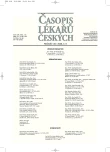Surgical Treatment of Infective Endocarditis: 8 Year Experience
Authors:
M. Kolek; R. Brát
Authors‘ workplace:
Kardiochirurgické centrum FNsP, Ostrava
Published in:
Čas. Lék. čes. 2006; 145: 718-724
Category:
Original Article
Overview
Background.
A retrospective study analysing effects of surgical treatment of active infective endocarditis was performed in our centre between January 1998 and December 2005.
Methods and Results.
57 consecutive patients with infective endocarditis underwent surgical intervention in active phase of infection (fulfilment of Durack diagnostic criteria, persisting elevation CRP at the time of cardiac surgery, indications for surgery according to actual guidelines of the Czech Society of Cardiology). Male to female ratio was 38:19. The patients’ mean age was 52.5 years without any significant differences among men and women. The most frequent causative agents were staphylococci – 28.1 % and streptococci – 19.3 %. 26 cases of aortic valve involvement were the most frequent, followed by 21 cases of mitral endocarditis, and 7 cases were both aortic and mitral valve endocarditis. 3 cases of tricuspid endocarditis were also observed. Native valve endocarditis prevailed over the prosthetic ones – 49 versus 8. Surgery was most often performed using a mechanical prosthesis (45 cases), bioprostheses were implanted in 13 patients and 6 patients underwent mitral or tricuspid valve repair operation. In 1 patient, the procedure was complemented with mitral valve annuloplasty, and in 5 patients, the operation was completed with tricuspid annuloplasty - because of significant regurgitation of other aetiology. Coronary artery bypass surgery (at the same time) was necessary in 9 patients. Surgery was followed by a significant shift from classes III and IV to classes I and II of NYHA classification. Relapsing or recurrent endocarditis developed in 7 %. Thirtyday mortality of patients who had undergone surgery for active infective endocarditis was 15.8 %, 9 patients died. During follow up period 7 patients died, the overall mortality was 28.1 %. Survivors were followed up for 0.5-90 (median 40) months.
Conclusions.
Operation for active infective endocarditis carries a relatively higher mortality in comparison with elective surgery. Nevertheless, this is acceptable because the operation in active phase is enforced by life-threatening complications and it also reduces assumed mortality at conservative therapy. Our results are comparable with data from other studies.
Key words:
infective endocarditis, surgery, valve replacement, valve repair.
Labels
Addictology Allergology and clinical immunology Angiology Audiology Clinical biochemistry Dermatology & STDs Paediatric gastroenterology Paediatric surgery Paediatric cardiology Paediatric neurology Paediatric ENT Paediatric psychiatry Paediatric rheumatology Diabetology Pharmacy Vascular surgery Pain management Dental HygienistArticle was published in
Journal of Czech Physicians

Most read in this issue
- Vacuum Assisted Closure Therapy – Overview of Lesson and Applications
- Surgical Treatment of Infective Endocarditis: 8 Year Experience
- History of the Czech Gerontology and Geriatrics
- Biological Mechanisms of Aging
